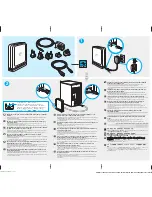
DVMRP is a dense-mode multicasting protocol and therefore uses a broadcast and
prune mechanism. The protocol builds a source-rooted tree (SRT) in a similar way
to PIM dense mode. DVMRP routers flood datagrams to all interfaces except the one
that provides the shortest unicast route to the source. DVMRP uses pruning to prevent
unnecessary sending of multicast messages through the SRT.
A DVMRP router sends prune messages to its neighbors if it discovers that:
■
The network to which a host is attached has no active members of the multicast
group.
■
All neighbors, except the next-hop neighbor connected to the source, have pruned
the source and the group.
When a neighbor receives a prune message from a DVMRP router, it removes that
neighbor from its (S,G) pair table, which provides information to the multicast
forwarding table.
When a host on a previously pruned branch attempts to join a multicast group, it
sends an IGMP message to its first-hop router. The first-hop router then sends a graft
message upstream.
Identifying Neighbors
In this implementation of DVMRP, a
neighbor
is a directly connected DVMRP router.
When you enable DVMRP on an interface, the associated VR adds information about
local networks to its DVMRP routing table. The VR then sends probe messages
periodically to learn about neighbors on each of its interfaces. To ensure compatibility
with other DVMRP routers that do not send probe messages, the VR also updates its
DVMRP routing table when it receives route report messages from such routers.
Advertising Routes
As its name suggests, DVMRP uses a distance-vector routing algorithm. Such
algorithms require that each router periodically inform its neighbors of its routing
table. DVMRP routers advertise routes by sending DVMRP report messages. For each
network path, the receiving router picks the neighbor advertising the lowest cost and
adds that entry to its routing table for future advertisement.
The cost, or metric, for this routing protocol is the hop count back to the source. The
hop count for a network device is the number of routers on the route between the
source and that network device.
Table 6 on page 126 shows an example of the routing table for a DVMRP router.
Table 6: Sample Routing Table for a DVMRP Router
Output
Port
Input
Port
Time Before
Entry Is Deleted
from Routing
Table
Metric
From Router
Subnet Mask
Source
Subnet
4/0, 4/1
3/0
85
4
143.32.44.12
255.255.0.0
143.2.0.0
126
■
Overview
JUNOSe 11.1.x Multicast Routing Configuration Guide
Содержание JUNOSE 11.1.X MULTICAST ROUTING
Страница 6: ...vi...
Страница 8: ...viii JUNOSe 11 1 x Multicast Routing Configuration Guide...
Страница 16: ...xvi List of Figures JUNOSe 11 1 x Multicast Routing Configuration Guide...
Страница 18: ...xviii List of Tables JUNOSe 11 1 x Multicast Routing Configuration Guide...
Страница 24: ...2 Internet Protocol Version 4 JUNOSe 11 1 x Multicast Routing Configuration Guide...
Страница 64: ...42 Investigating Multicast Routes JUNOSe 11 1 x Multicast Routing Configuration Guide...
Страница 100: ...78 Monitoring IGMP Proxy JUNOSe 11 1 x Multicast Routing Configuration Guide...
Страница 145: ...Monitoring PIM 123 Chapter 3 Configuring PIM for IPv4 Multicast...
Страница 146: ...124 Monitoring PIM JUNOSe 11 1 x Multicast Routing Configuration Guide...
Страница 166: ...144 Monitoring DVMRP JUNOSe 11 1 x Multicast Routing Configuration Guide...
Страница 168: ...146 Internet Protocol Version 6 JUNOSe 11 1 x Multicast Routing Configuration Guide...
Страница 204: ...182 BGP Multicast JUNOSe 11 1 x Multicast Routing Configuration Guide...
Страница 263: ...Part 3 Index Index on page 243 Index 241...
Страница 264: ...242 Index JUNOSe 11 1 x Multicast Routing Configuration Guide...
















































